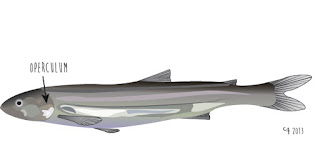Last Saturday, I had the pleasure of accompanying some folks as they caught hooligan- these little silver fish that are currently spawning here in the river. I helped to bag them up and in the process, got covered in their sperm (I couldn’t be mad- we did interrupt them mid-spawn with their little zippers down). Afterwards, I tagged along to drop by the local high school prom to check out the dresses (and seeing as I was super excited about this, I’d say I’m adjusting well to small-town Alaskan life). But the highlight of the weekend was being able to tell my mom the next day on the phone “last night I went to the prom and got sperm in my hair.”
Currently, these hooligan fish are swimming up the Chilkoot
River here. They’re pretty little silver fish with tones of pinks and purples.
They’re pretty general looking, which makes this occasion a perfect opportunity
to relay a little general fish morphology.
Fins
 |
| Hooligan fins |
Fins are the evolutionary answers to fishy locomotion.
Pectoral and pelvic fins project from the body and can move in a rotational
manner, acting as little steering arms for the fish.
The dorsal fin can occur in one part or two parts, with the
more anterior fin always being the primary one and the back one usually being
smaller and squishier. In the case of the hooligan, there are two dorsal fins.
The dorsal fin(s) act as sails for the fish, slicing through the water with
lateral surface area that pushes against the water on either side of the fish.
This keeps the fish from tipping over, keeping it right side up. The anal fin
functions in balance as well, in charge of more refined adjustments to keep Mr.
Fish from tumping over.
Lastly, the caudal (caud
being latin for tail) fin is the big daddy in the back that swings from side to
side to move the fish forward.
Lateral line
You can peer into the water and see these hooligan swimming
against the current in their little groups. They seem to almost have telepathic
abilities- knowing and reacting instantaneously to what their fish friends are going to do.
Have you seen those nature shows that show schools of fish all turning and
darting in what seems to be perfect unison? How do they do it?
 When you look at fish, you’ll notice a faint line that runs
down their sides. This is called the lateral line. Lateral lines are actually a
series of nerve clumps that act as a composite sensory organ. On the surface, the
lateral line is a series of sensory epithelial cells that hook up to the
underlying nervous system, which translates the sensations felt by the surface
cells to electrical impulses that are sent to the brain. These sensations are
caused by minute pressure changes in the fish’s immediate environment. The
flick of a neighboring fish’s tail, the opening jaws of a nearby predator, or
the creeping legs of a delicious crustacean- the lateral line allows all of
these things to be sensed without being heard or seen.
When you look at fish, you’ll notice a faint line that runs
down their sides. This is called the lateral line. Lateral lines are actually a
series of nerve clumps that act as a composite sensory organ. On the surface, the
lateral line is a series of sensory epithelial cells that hook up to the
underlying nervous system, which translates the sensations felt by the surface
cells to electrical impulses that are sent to the brain. These sensations are
caused by minute pressure changes in the fish’s immediate environment. The
flick of a neighboring fish’s tail, the opening jaws of a nearby predator, or
the creeping legs of a delicious crustacean- the lateral line allows all of
these things to be sensed without being heard or seen.
Gills
Gills are NOT underwater versions of lungs. They are
entirely different structures from different origins, but do have the shared
function of oxygen acquisition. In fact, they are quite superior in this area,
what with their countercurrent oxygen exchange and all. Just looking at a fish,
you usually don’t get a glimpse of these delicate, feathery gills. They are
covered up and protected by a bony covering called the operculum. If you were
to snap this off (of a dead fish only, don’t be mean!), you could then see the
feathery, vessel-laden projections that serve as oxygen exchange sites for the
fish.
So even though fish are slimy, they’re still worth getting to know. Living underwater presents a whole
different set of challenges- but not to worry. These little guys have got it
covered. Much like I was in their sperm.


No comments:
Post a Comment